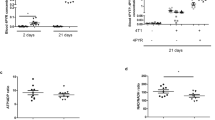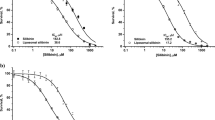Abstract
Purpose: To assess parameters that might determine resistance to the topoisomerase I inhibitor, camptothecin (CPT), the sensitivities of three established human breast cancer cell lines (ER−) and of normal bovine endothelial cells to CPT in the free form and incorporated into liposomes (LCPT), were contrasted with topoisomerase I (topo I) content and activity, and with cell cycle response to CPT treatment. Methods: Drug sensitivities were determined using the tetrazolium dye assay and by 3H-thymidine incorporation. Topo I levels were determined by Western blot analysis, and catalytic activity was determined with a plasmid relaxation assay, using nuclear protein from each cell line. CPT stabilization of cleavable complexes in nuclear extracts was determined using a labeled oligonucleotide with a specific topo I cleavage site. Cell cycle response to CPT was determined by flow cytometric analysis of propidium iodide-stained nuclei. Results: CPT was extremely potent against MDA-MB-157 cells with an IC50 value of 7 nM compared with IC50 values of 150 nM for GI 101A and 250 nM for MDA-MB-231 cells. In contrast, CPT inhibited the incorporation of 3H-thymidine at very low doses in GI 101A and MDA-MB-231 cells with IC50 values of 9 nM and 5 nM, respectively; while MDA-MB-157 cells did not stop incorporating 3H-thymidine until very high doses (500 nM ) of CPT were used. When incorporated into multilamellar liposomes (LCPT), CPT retained its potency, with IC50 values similar to that of the free drug. No correlation was found between CPT-induced cytotoxicity and any of the topo I parameters determined. Cell cycle analysis, however, showed an accumulation of cells in G2/M phase after 24 h treatment with low doses (5 nM) of CPT in only GI 101A and MDA-MB-231 cells with no arrest in normal endothelial or MDA-MB-157 cells. At higher doses (50 nM), however, a dramatic accumulation of cells in the S phase was observed in MDA-MB-157, MDA-MB-231 and GI 101A cells. In contrast, a G2/M phase block was seen with the normal bovine endothelial cells using the higher doses of CPT. Conclusions: The results suggest that cell cycle regulation plays an important role in determining the effect of CPT on malignant and normal cells. The possible mechanisms explaining the sensitivities of the two cellular compartments to the action of CPT are discussed.
Similar content being viewed by others
Author information
Authors and Affiliations
Additional information
Received: 21 October 1996 / Accepted: 5 March 1997
Rights and permissions
About this article
Cite this article
Jones, C., Clements, M., Wasi, S. et al. Sensitivity to camptothecin of human breast carcinoma and normal endothelial cells. Cancer Chemother Pharmacol 40, 475–483 (1997). https://doi.org/10.1007/s002800050690
Issue Date:
DOI: https://doi.org/10.1007/s002800050690




